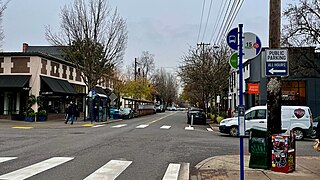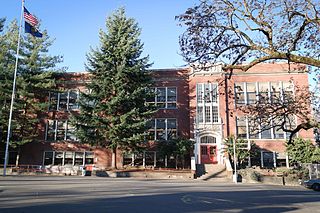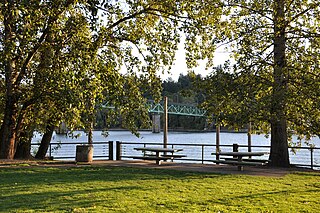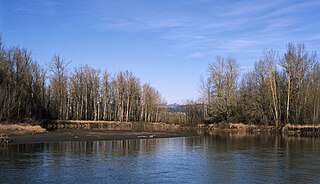
A dog park is a park for dogs to exercise and play off-leash in a controlled environment under the supervision of their owners.

Forest Park is a public municipal park in the Tualatin Mountains west of downtown Portland, Oregon, United States. Stretching for more than 8 miles (13 km) on hillsides overlooking the Willamette River, it is one of the country's largest urban forest reserves. The park, a major component of a regional system of parks and trails, covers more than 5,100 acres (2,064 ha) of mostly second-growth forest with a few patches of old growth. More than 80 miles (130 km) of recreational trails, including the Wildwood Trail segment of the city's 40-Mile Loop system, crisscross the park.

Three Rivers Park District is a special park district serving the suburban areas of the Twin Cities including suburban Hennepin, Carver, Dakota, Scott, and Ramsey counties. Three Rivers's mission is "To promote environmental stewardship through recreation and education in a natural resources-based park system." Three Rivers operates twenty parks and ten regional trails, with at least two more regional trails planned. Nearly seven million people visit Three Rivers facilities each year. It has over 27,000 acres (11,000 ha) of parks and trails.

The Northwest District is a densely populated retail and residential neighborhood in the northwest section of Portland, Oregon, United States. Craftsman-style and Old Portland-style houses are packed tightly together with old apartment buildings and new condominiums, within walking distance of restaurants, bars, and shops. The Portland Streetcar's first line terminates there, connecting the district to the Pearl District, Downtown Portland and points south to the South Waterfront, and several TriMet bus lines also serve the district.
Goose Hollow is a neighborhood in southwest Portland, Oregon. It acquired its distinctive name through early residents' practice of letting their geese run free in Tanner Creek Gulch and near the wooded ravine in the Tualatin Mountains known as the Tanner Creek Canyon. Tanner Creek Gulch was a 20-block-long, 50-foot-deep (15 m) gulch that started around SW 17th and Jefferson and carried the waters of Tanner Creek into Couch Lake. Over a century ago, Tanner Creek was buried 50 feet (15 m) underground, and the Tanner Creek Gulch was filled in. The only remaining part of the hollow is the ravine, Tanner Creek Canyon, carved out by Tanner Creek through which The Sunset Highway carrying US-26 passes and which the Vista Bridge spans, also called the Vista Viaduct.

Kennedy Grove Regional Recreation Area (KGRRA), also known simply as Kennedy Grove, is located in Richmond, Contra Costa County, California at the base of San Pablo Dam. Created in 1967, it contains a three-mile hiking trail with an elevation of 760 feet (230 m). The Grove features many large eucalyptus trees, picnic areas, volleyball nets, playgrounds, and horseshoe pits. Bird watching is popular here because hawks are almost always spotted. Some hikers have reported seeing golden and bald eagles around the reservoir. There is no camping allowed. Parking is $5 with an extra $2 fee for a dog. Dogs have to be on the leash around the lawn but they are allowed off the leash in remote parts of the park. The park is open from 8 a.m. to dusk.

Gabriel Park is a 90.65-acre (366,800 m2) public park in Portland, Oregon, United States. It features a baseball field, softball field, soccer field, basketball courts, tennis courts, skatepark, volleyball courts, disabled access play area, disabled access restrooms, dog off-leash area, paved and unpaved paths, reservable picnic sites, and WiFi. The park is located between the Maplewood, Multnomah, and Hillsdale neighborhoods of Southwest Portland at 45th Avenue and Vermont Street.

Delta Park is a public municipal park complex in north Portland in the U.S. state of Oregon. Delta Park is composed of two distinct sections referred to as East and West Delta Park. The Owens Sports Complex is a notable attraction of East Delta Park, bringing teams from across the West Coast to compete in an array of sports.

The Metropolitan Learning Center (MLC) is an alternative public school serving K–12 students in Portland, Oregon, United States.

Cooper Mountain Nature Park is a 231 acres (93 ha) nature park in the Portland metropolitan area in the U.S. state of Oregon. Opened in 2009, the park is owned and operated by Metro, the regional government in the Oregon portion of the metro area. The park is named after Cooper Mountain, the primary geological feature in the area near Beaverton. Maintained by the regional Tualatin Hills Park and Recreation District, the natural area has 3.5 miles (5.6 km) of hiking trails. It is one of THPRD's two nature parks, along with the Tualatin Hills Nature Park.

The North Park Blocks form a city park in downtown Portland, Oregon, in the United States. Most of the park is in northwest Portland, but one block is in southwest Portland.

Laurelhurst Park is a city park in the neighborhood of Laurelhurst in Portland, Oregon. The 26.81-acre (10.85 ha) park was acquired in 1909 from the estate of former Portland mayor William S. Ladd. The City of Portland purchased the land in 1911, and the following year park superintendent Emanuel Mische designed the park in accordance with the Olmsted Plan.

Irving Park is a city park in northeast Portland, in the U.S. state of Oregon. Measuring about 16 acres (6.5 ha), it was designed by landscape architect Florence Holmes Gerke. It is located at Northeast 7th Avenue and Fremont Street in the Irvington neighborhood. The park is on land that was originally owned by William Irving, for whom the neighborhood was named. The Irvington Racetrack once occupied part of the land.

Willamette Park is a city park of about 26 acres (11 ha) in south Portland, in the U.S. state of Oregon. Located at Southwest Macadam Avenue and Nebraska Street, the park includes a boat dock and ramp, paved and unpaved paths, picnic areas, restrooms, a dog off-leash area, playground, soccer field, and tennis courts.

Sellwood Riverfront Park is a city park of about 7.6 acres (3.1 ha) in southeast Portland, in the U.S. state of Oregon. Located at Southeast Spokane Street and Oaks Parkway, the park has paths, picnic tables, a stage, a boat dock on the Willamette River, restrooms, and a dog off-leash area.

Alberta Park is a park located in northeast Portland, Oregon. Acquired in 1921, the park includes a basketball court, dog off-leash area, playground, soccer field, softball field and tennis court, as well as paved and unpaved paths and picnic tables. The park is maintained by a volunteer group known as Friends of Alberta Park.

Woodstock Park is a public park located in the Woodstock neighborhood of southeast Portland, Oregon, in the United States.

Wilshire Park is a 14.4-acre (5.8 ha) public park in northeast Portland, Oregon, United States. Situated within the Beaumont-Wilshire neighborhood, the park was acquired by the city in 1940, and is maintained by Portland Parks & Recreation. The park features a variety of facilities and uses including playgrounds, an off-leash dog park, baseball fields, picnic tables, and a 0.6 mile loop trail.

Berkeley Park is a 6.48-acre (2.62 ha) public park in Portland, Oregon, United States. Acquired in 1941, the park has a playground, fields for multiple sports, and tennis courts, among other features.

The Sandy River Delta is a natural area at the confluence of the Sandy and Columbia rivers in Oregon. Also known as "thousand acres", Sandy River Delta is composed of 1,400 acres administered by the United States Forest Service as part of the Columbia River Gorge National Scenic Area near the Portland metro area and the city of Troutdale.























